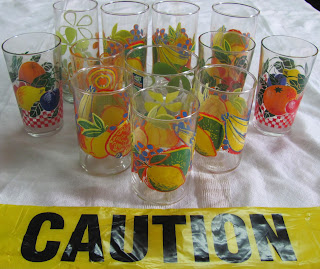Toxics Watchdog: Lead-Tainted Christmas Mugs Not Merry; Funny Glasses Risky
A health and environmental watchdog detected alarming levels of lead, a highly toxic substance, in glasses with colorful fruit and flower designs and also in mugs decorated with Christmas symbols, which are common gift ideas during the yuletide season.
The EcoWaste Coalition, a group dedicated to reducing childhood and occupational exposure to lead, rang the alarm bell after screening a total of 35 samples (12 pieces of glass tumblers and 23 pieces of ceramic mugs) for heavy metals using a portable X-Ray Fluorescence (XRF) spectrometer.
The group conducted the probe to generate data that will show the need to ban lead in glazes and paints used for food contact articles such as glasses, mugs and plates in the Chemical Control Order for lead and lead compounds being crafted by the Department of Environment and Natural Resources - Environmental Management Bureau.
The recent filing by Rep. Rufus Rodriguez of Resolution 2812 asking the House Committees on Health and Trade and Industry to conduct an investigation on the need to regulate lead and other chemicals of concerns in mugs and related products provided another impetus to initiate the probe.
The 35 samples were purchased from October 14-16, 2012 from bargain stores located in the cities of Mandaluyong, Manila and Quezon for P20 up to P99.
Of the 12 glasses analyzed, lead was detected in all the samples in the range of 14,700 parts per million (ppm) to 56,600 ppm, with the average lead content at 39,100 ppm, exceeding the US limit of 90 ppm used as a benchmark for lead in paint.
Of the 23 mugs, lead ranging from 106 ppm to 20,900 ppm was detected in 18 samples, with the average lead content at 12,025 ppm.
While no detectable levels of lead were found in five mugs, elevated levels of either cadmium, chromium or both were found in all of them.
Aside from lead, significant quantities of toxic metals above levels of concern were detected in all the 35 samples, including antimony (the highest level found was 1,121 ppm), arsenic (6,734 ppm), cadmium (9,296 ppm) and chromium (9,622), which may bring about multiple chemical exposures.
“We were shock to find extreme amounts of lead on beautifully decorated glasses and mugs that directly touch the lips of users, including children, and may come in contact with the beverage or food that is consumed,” said Aileen Lucero of the EcoWaste Coalition’s Project Protect.
Some of the tainted samples were embellished with popular yuletide emblems such as Santa Claus and his reindeers, Christmas trees, stars and other ornaments, she noted.
“Since lead is highly toxic and builds up in the body, health specialists recommend that we avoid lead as exposure even to minute levels may have a lifelong consequences, especially for developing fetuses and children,” she said.
“Lead-containing glazes and paints should not be used in beverage and food containers, vessels and utensils as a precaution against the possibility of lead leaching or seeping,” she emphasized.
“Also, dinnerware sold in the country should be properly marked to indicate if lead-based glaze or paint was used on the products. Consumers have the right to know what’s on their glasses, mugs and plates. There should be warning labels on items with lead,” she added.
To guard against lead exposure from beverage as well as food containers, the EcoWaste Coalition advises consumers to take the following precautions:
- Refrain from buying items, especially highly decorated ones, with no written assurance of being lead-safe. Check the labels.
- Avoid use of lead-glazed or lead-painted cups, glasses, mugs and plates, especially for hot beverages and foods.
- Do not store pickled fruits and vegetables, fruit juices and other acidic foods or preparations in ceramic containers, including collectibles or antiques that may contain lead.
-Do not store beverages in lead crystal containers.
- Do not feed babies from lead crystal bottles (breastfeed or opt for lead-free glass bottles or BPA-free plastic bottles).
-Do not use ornamental kitchenware or tableware to prepare, serve or store drinks and foods. Watch out for “Not for Food Use” or “For Decorative Purposes Only” warnings and follow them.
According to the United States Environmental Protection Agency, exposure to lead can result in learning disabilities; attention deficit disorder; decreased intelligence; speech, language and behavior problems; poor muscle coordination; constipation; sleeping disorders; high blood pressure; muscle and joint pain; birth defects; and damage to the nervous system and kidneys.
-end-
Reference:







Comments